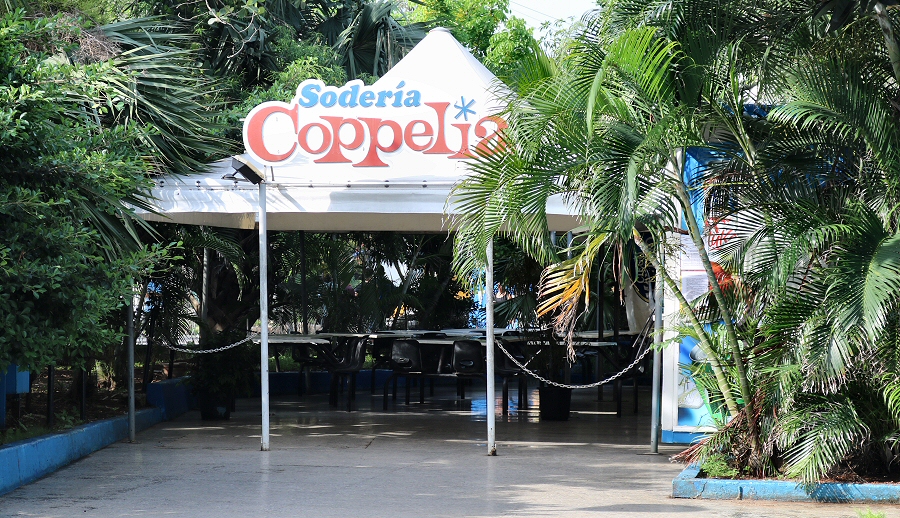
The
state-run Coppelia is one of the landmarks of Havana. In the
meantime, it is the flagship of a chain, spread across the
island and one of the largest ice cream parlors on the
world. The so-called cathedral of ice cream serves in a
modernist building in one of the busiest centers of the
capitol.
The plot that Coppelia occupies
today, was chosen to build the Hospital Reina Mercedes that
was inaugurated in 1886. When the hospital was demolished in
1954, it was intended to build another hospital in its
place, but the land had increased extremely in its value, as
it was in the heart of the city. Thus, the idea to build a
skyscraper with 50 floors was put forward, but it remained
just as a project. Instead, on the initiative of the
Instituto Nacional de Industria Turística (INIT), a park was
built at the same place to attract the tourists. Small hills
were created in the park and an artificial lake and
fountains were added to the place. The cafeteria, bar and
restaurant complex had a capacity of 500 persons. After one
year, it was transformed into Centro Recreativo Nocturnal
(night-time entertainment center).
In 1966, the Coppelia ice cream
shop was inaugurated in a huge concrete building in the
center of the park. Its sketch belongs to the Cuban
architect Mario Girona that used the plasticity of
reinforced concrete, inspired by the modernist trend in
Italy, Mexico and South America. The Project was conducted
by the Cuban engineers Maximiliano Isoba and Gonzalo Paz.
The ice
cream shop is named by Fidel Castro’s longtime secretary
Celia Sánchez after her favorite ballet Coppélia. Coppélia
is the mythical character of the comic ballet with the same
name that is originally choreographed by Arthur Saint-Léon
to the music of Léo Delibes. It bases upon two stories by E.
T. A. Hoffmann: Der Sandmann (The Sandman) and Die
Puppe (The Doll). In Greek, κοπέλα means young woman.
The underlying reason for
establishing such a gigantic ice cream shop was the idea of
Fidel Castro that wanted to prove the capability of Cuba in
producing ice cream better than the big American brands. He
aimed to create a place where the Cubans would eat ice
cream, as much as they wanted for a price low enough for
everyone.
The ice
cream that the ambassador of Cuba in Canada had sent to
Fidel in 1960s, led Fidel Castro to come to such a
conclusion. The ice cream belonged to Howard Johnson’s that
was an American chain of hotels and motels located primarily
throughout the US and Canada. It had also once been a chain
of restaurants and it was thought to be the best ice cream
producer at that time, offering 28 different tastes of ice
cream (Its ice cream is no longer manufactured). After
tasting all the 28 containers with different flavors, Fidel
Castro formulated his motto: ¡Helado por el pueblo!
(Ice cream for People) and ordered to import the latest ice
cream equipment from Netherlands and Sweden. Subsequently, a
factory was set up beside the road to the airport to produce
the qualified Cuban ice cream.
The concrete building is
reminiscent of a concrete tent for some, a tea plate turned
upside down for some, or a spaceship (probably an UFO)
landed on the Earth for some. The giant circular roof with a
diameter of 40 meters is supported by twelve reinforced
concrete arachnid columns. It is topped by a skylight of
colored glass in the shape of a small tower that is four
meters high and five meters in diameter. The upper
floor of the two-storey building can be accessed through a
helicoidal staircase. The upper floor consists of five large
discs, divided by wood and tinted glass panels.
Together with the open area, it
reaches a capacity of maximum 1.000 guests.
It occupies the entire block,
bordered by the 23rd, 25th, K and L streets. The park area
surrounding the building looks like a beautiful jungle,
consisting of palms, rubber trees, figs and banyan trees.
There is also a large parking lot.
Coppelia gained additional fame by
the Oscar nominated, 1933 Cuban film Fresa y Chocolate
(Strawberry and Chocolate). Two of the ice cream shop’s most
popular flavors carry the name of this film.
When the ice cream shop was
opened, it was offering the ice cream in 26 different
flavors, so that it won the favor of the Cubans in a short
time.
Following the collapse of the
Soviet Union, Cuba entered an economic crisis, as it had
lost is major financial source. The new situation also
slammed into the ice cream production. Consequently, the
variety of flavors was reduced to two or three, and the
quality of the ice cream was impaired. Even though, Cuba got
over this Special Period, Coppelia’s ice cream is never
restored to the original to the general opinion of the
senior citizens.
Currently, both during weekends
and weekdays, from early morning to late evening, there are
still people patiently waiting in long lines, even though
the assortment decreased to 4-5 flavors and other good
qualified ice cream shops are opened in the city. Coppelia
is still a place where the Cubans of
all ages, black and white, rich and poor, meet,
taste exotic flavors such as coconut, mango or guava, chat
and flirt under the same roof.
It opens at 10:00 every day, but
it is not an unusual thing to see people waiting in the line
at least an hour before. There are different lines for the
indoors or the outdoors area. After over an hour, it will be
finally your turn. On an average day, the number of the
available flavors don’t exceed five. The ice cream is served
in a plastic bowl, doused with syrup,
and with cookie crumbs. Sometimes, you may be
asked to share your table with others.
